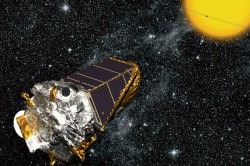Planets are so very tiny next to stars outside of the solar system, making it really hard to spot exoplanets unless they transit across the face of their star (or if they are very, very big). Often, astronomers can only infer the existence of planets by their effect on the host star or other stars.
That’s especially true of the curious case of Kepler-88 c, which researchers using the Kepler space telescope said was a possible planet due to its effects on the orbit of Kepler-88 b, a planet that goes across the host of its host star. European astronomers just confirmed the Kepler data using the SOPHIE spectrograph at France’s Haute-Provence Observatory.
It’s the first time scientists have successfully used a technique to independently verify a planet’s mass based on what was found from the transit timing variation, or how a planet’s orbit varies from what is expected as it goes across the face of its sun. That means TTV can likely be used as a strong method on its own, advocates say.

SOPHIE’s technique relies on measuring star velocity, which also can reveal a planet’s mass by seeing its effect on the star.
“This independent confirmation is a very important contribution to the statistical analyzes of the Kepler multiple planet systems,” stated Magali Deleuil, an exoplanet researcher at Aix-Marseille University who participated in the research. “It helps to better understand the dynamical interactions and the formation of planetary systems.”
Actually, the two planets behave similarly to Earth and Mars in our own solar system in terms of orbits, according to work from a previous team (led by David Nesvorny of the Southwest Research Institute). They predicted the planets have a two-to-one resonance, which is approximately true of our own solar system since Mars takes about two Earth years to orbit the sun.
The new research was led by S.C.C. Barros at Aix-Marseille University in France. You can read the study in the Dec. 17 edition of Astronomy & Astrophysics, or in preprint version on Arxiv.

